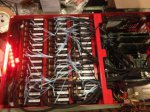jgreco --- "So definitely the 846A (not the TQ, you don't want 24 discrete connectors)".. why not? I admittedly don't understand.
4 SAS lanes are 4 SAS lanes, whether they're discrete or bundled.
The BPN-SAS-846TQ has 24 discrete connectors, so you need 24 single lane SAS/SATA cables. That's 24 cables that you can't afford to bump or dislodge.
The BPN-SAS-846A has 6 SFF8087 ("IPASS") connectors, each of which bundles 4 lanes, so you only need 6 SFF8087 cables, which are engineered for a much better positive-locking experience.
That's why I said that the A is better than the TQ. It's the same thing, except without 24 SATA connectors.
So are you saying you would get the same performance using a single cable from an HBA to a backplane that holds 36 drives? (seriously, not being a smart-ass, more like a newb being a dumb-ass). I guess the bottom line question is, does FN run well with one of the SuperMicro enclosures that holds 24/36 drives?... I want to get away from this at some point...
It sounds like you're confused about SFF8087, though, since the only way you could have a single cable would be if you had an SAS expander backplane like the BPN-SAS2-846EL2 (featured in chassis like the 846BE26). In that scenario, you could have one SFF8087, which has four SAS channels, each of which is 6Gbps, so the overall link is 24Gbps between the HBA and the expander. In theory you can go wider, but I had some trouble with that and didn't try real hard. But in that case, yes, you get a single SFF8087 attaching a bunch of drives.
It comes down to a matter of mathematics, two ways:
Today's spinny rust drives are capable of about 150MB/sec, though the latest 6TB's I have peak around 200MB/sec. So if you take 24 drives * 150MB/sec * 8 bits/byte, you get 28.8Gbps. Of course there's overhead and stuff, but the takeaway is that 28.8Gbps is only slightly bigger than 24Gbps. You are not likely to run into serious contention issues because your host probably isn't able to drive all those disks at 100% utilization all the time anyways.
Today's networks are 1GbE or 10GbE, so if your backend is 24Gbps, that's larger than the 2 x 10GbE which is probably the maximum network config most people would be looking at.
Anyways, so for the 36 drive 847BE26, it actually has two expanders in it, one for the front drives, one for the rear. So from the point of view we're talking about here, the 846 and 847 are equal except that the 847 uses two SFF8087's instead of one. So the increase from 24 to 36 drives doesn't increase contention unless you maybe do something dumb like daisy chain the backplanes (which you can totally do, of course, if you don't mind the contention).
The newer SC846BE2C sports the new SAS3 expander and 12Gbps links instead of the 6Gbps of the SAS2 boards discussed herein.
There's some motivation to avoid excessive cabling in servers as your picture notes. The downside to SAS expanders is that they occasionally don't play nice with SATA drives, but the compatibility matrix is kind of a "who knows."
In the end, to repeat your question:
I guess the bottom line question is, does FN run well with one of the SuperMicro enclosures that holds 24/36 drives?...
FreeNAS has no clue about the enclosure. All it knows is the HBA and a little bit about the SAS expander. I've got an 846BE26 here with 12x Seagate desktop 4TB drives in RAIDZ3 that works just fine. Note that the BE26 is arguably useless in this config, since SATA doesn't use the secondary expander, so if you're building a dedicated FreeNAS box and not using dualported SAS, get the single expander version.
I thought I had some good performance specs there for some solid IOPs. I worry now. But I guess numbers will show us where I stand.

